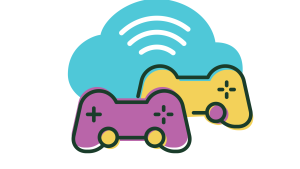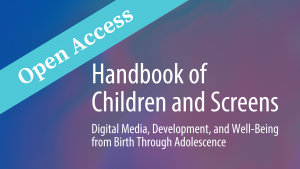The majority of today’s adolescents are video gaming – for many, daily. How much gaming is too much ? Are violent video games actually harmful to children? On this episode of Screen Deep, host Kris Perry sits down with Dr. Douglas Gentile, a Distinguished Professor at Iowa State University and renowned video gaming expert. Dr. Gentile discusses the latest research on which aspects of gaming can affect child health and development, and the effects of violent media – including video games – on children’s aggressive feelings and behaviors. He also discusses the prevalence of gaming addiction and what features of games make them potentially addictive to children. Finally, Dr. Gentile explains how video games can have positive effects on social behavior and learning as well, and the power parents have to influence their children’s media use and behavioral outcomes.
Listen on Platforms
About Douglas Gentile
Dr. Douglas A. Gentile is a Distinguished Professor of Psychology at Iowa State University. He has authored over 150 peer-reviewed scientific journal articles, including studies on the positive and negative effects of mass media on children in several countries. His most recent books include Game On! Sensible Answers about Video Games and Media Violence, Learning from Video Games (and everything else), and Finding the Freedom to Get Unstuck and be Happier. He is a Fellow of the American Psychological Association, the Association for Psychological Science, the Society for the Psychological Study of Social Issues, and the Society for Personality and Social Psychology. He was honored with the Distinguished Lifetime Contributions Award to Media Psychology and Technology by the American Psychological Association, and he was named one of the Top 300 Professors in the United States by the Princeton Review.
In this episode, you’ll learn:
- How the 5 “C’s” of video gaming work together to impact child behavior and health.
- Why violent video games are linked to increased aggression in youth – and three major effects of violent media.
- Why even “cute” animated video games can increase aggression in kids, just as realistically violent games.
- How many children are struggling with gaming addiction – and how to recognize the warning signs .
- When video games help children learn and encourage prosocial behavior.
Studies mentioned in this episode, in order mentioned:
Linz, D., Donnerstein, E., & Penrod, S. (1988). Effects of Long-Term Exposure to Violent and Sexually Degrading Depictions of Women. Journal of Personality and Social Psychology, 55(5).
Anderson, C. A., Gentile, D. A., & Buckley, K. E. (2007). Violent video game effects on children and adolescents: Theory, research, and public policy. Oxford University Press. https://doi.org/10.1093/acprof:oso/9780195309836.001.0001
Limone, P., Ragni, B., & Toto, G. A. (2023). The epidemiology and effects of video game addiction: A systematic review and meta-analysis. Acta psychologica, 241, 104047. https://doi.org/10.1016/j.actpsy.2023.104047
Gentile, D. A., Reimer, R. A., Nathanson, A. I., Walsh, D. A., & Eisenmann, J. C. (2014). Protective effects of parental monitoring of children’s media use: A prospective study. JAMA pediatrics, 168(5), 479-484.
[Kris Perry]: Hello and welcome to the Screen Deep podcast, where we go on deep dives with experts in the field to decode young brains and behavior in a digital world. I’m Kris Perry, Executive Director of Children and Screens and the host of Screen Deep.
Anyone who interacts with kids knows just how much children and adolescents are video gaming these days. Whether it’s too much and has become a problem is a concern for many parents. Joining me today to talk about the actual impacts of youth videogaming is Dr. Douglas Gentile, a Distinguished Professor in Liberal Arts and Sciences at Iowa State University and an expert on youth video gaming. Dr. Gentile has literally written the book on understanding the complexities of problematic gaming and the possible link between violent video games and behavioral aggression. Let’s dive in. Welcome, Douglas.
[Dr. Douglas Gentile]: Hi Kris, it’s good to see you.
[Kris Perry]: Let’s get right to the heart of the matter. Many parents are deeply worried about their children’s almost-constant gaming. I know at our Ask the Experts webinar on video gaming, you shared some insights about how it’s difficult to say whether video gaming is “good” or “bad.” Can you tell us a short list of factors to consider when evaluating whether an individual child’s game use is healthy or problematic?
[Dr. Douglas Gentile]: Sure. Well, games have multiple effects on us at multiple psychological levels. And that’s what makes it hard to say “is it good or bad,” because you might like some of those effects and dislike others of those effects. So to some extent, it really depends on what types of games the children are playing, what those children are generally like anyhow.
So for example, children who perhaps already have some trouble maintaining good boundaries with aggressive behaviors probably shouldn’t be playing violent games. Children who have problems with boundaries of making sure they get their homework done and their chores done—probably they need some help setting limits on the gaming. So gaming is neither good nor bad, or we can’t really reduce it simply to that.
But we can certainly recognize that for every hour a child’s on a video game, they’re not reading, they’re not doing homework, they’re not creating, they’re not exploring, they’re not doing any number of, you know—they’re not engaging socially with friends in the real world, or, you know, spending good family time. So it’s not just what are the games doing to children, but what aren’t the children getting because of their gaming? And so it does become very complex very quickly.
[Kris Perry]: At our webinar, you talked about five lenses, or factors, to consider when it comes to gaming. And I was hoping you might just explain each of those and whether or not they might be healthy or problematic as you go through the list.
[Dr. Douglas Gentile]: Sure. So, the first one that most parents are concerned about is how much time kids are spending, and certainly the amount of time does matter and it’s related to a whole bunch of things such as poor school performance, greater risk for attention deficit problems, greater physical health problems, and greater risk for becoming addicted to the gaming.
The other thing that parents are often concerned about is the content of the games and it turns out content matters greatly. If you play Reader Rabbit, your reading skills improve. If you play Math Blaster, math skills improve. If you play prosocial games where you have to take care of other characters and care about them and show empathy for them, in fact, empathy does tend to go up and helpful and cooperative behaviors in the real world go up. And if they’re playing violent games, well, kids become desensitized and they learn to be more willing to behave aggressively when provoked. So content, luckily, is a pretty easy thing for parents to control because they can, you know, go out and read reviews about what’s in this game, what gets rewarded, what do you have to do to get ahead in the game and decide which games are appropriate. And those are the two things most parents think about.
But there are other effects as well. One is what you could call the “structure.” How is it structured on the screen? How do you get information off of the screen? And I’ll give an example. In film and TV, if you, say, you watch a man and a woman go into a bedroom and close the door and it fades to black, we take a very specific meaning of what we think happened behind that door. If you see the same man and same woman go behind the same door, close it, and it cuts to a new scene, we actually don’t take away the same psychological meaning. So a fade edit or a cut edit actually has profoundly different psychological influence on us. So – but that’s not about the content. The content was identical. That’s about how it’s structured. And so, many games, for example, you have to navigate through a three-dimensional world, even though you’re just looking at two-dimensional images. So that would improve, say, 2D to 3D transfer skills. Many games you have to pick up information lots of places on the screen and maintain it or maintain three-dimensional awareness of what’s behind you or above you as well. And so playing those types of games that use the structure of the kind of what we might think of as the physical space of the game and the information gathering in the game, that can improve those types of skills.
The fourth effect is what we could call the “context,” both in-game and out-of-game. There are some games that you need to be able to play with other people to be able to be successful. And to the extent that you’re playing games with friends, and maybe you’re doing violent things, and you’re getting rewarded by your friends, that could actually enhance the aggression effect. Or it could be that, if you’re playing with your friends and you have the motivation of helping your team, maybe in fact that prosocial motive overrides the aggression. We actually don’t know the answer to that. That’s a great dissertation project for someone. But the context could shift it.
And the fifth effect is the mechanics. How you use the input devices, what types of controllers, how you actually need to move to be able to get around the game. Now we can talk about these, and I have, as if they’re theoretically distinct, but in fact they’re pretty complicated interacting with each other because, for example, mechanics and structure go hand in hand. As I move my thumbs, what I see on the screen changes. That’s what we usually call “hand-eye coordination.” If the game requires me to be part of a team, to access parts of the game and I’m just playing solo, well, my content will be different than your content if you’re playing with a team. I won’t be able to get to see parts of that game.
So, again, there are these five different dimensions and we can look at how each of them has an effect on its own, but in fact, they’re always working together. And that’s again why it makes it hard to say something like “games are good or bad.” If your child is spending a lot of time playing a violent game, the lot of time probably means poorer school performance. The violent content probably means more aggressive attitudes and feelings and, perhaps, those will start leaking out into behaviors. If it’s, say, a first-person shooter game, they’re going to get better at targeting skills, they’re going to increase their useful field of view, so getting information off of the periphery better and quicker, so improved perceptual skills. If they’re playing with friends, that might enhance or mitigate the aggression effect. And if they’re playing on a mouse and keyboard, their mouse and keyboard skills will improve. So is that good or bad? Well, it depends which of those you care about more.
[Kris Perry]: Thank you so much for that explanation of the important effects at play while gaming. Are there differences in potential effects from these gaming factors that you’ve just described based on the age of the child playing?
[Dr. Douglas Gentile]: “We don’t know” is the correct scientific answer. There are a lot of hypotheses out there that younger children are more vulnerable. And maybe that’s true in the sense that they— say they’re playing violent games. One of the main themes in a violent game is that violence solves problems. Right? No matter what the problem, you know, being aggressive is the solution. It’s kind of also what TV tends to teach across lots of shows, as well. Well, adults can see beyond that. Adults have other ways of responding besides that as a first choice. Maybe a young child just doesn’t have a bunch of, you know, other self-control or other options available to them. So in that sense, they’re more vulnerable. They’re more vulnerable in the sense they may not really understand the context of the game. And just telling them, “Oh, it’s only a game” doesn’t help, because young children really can’t use that cognitive information very usefully. In fact, adults aren’t really very good at that, either.
But people have thought maybe boys are more influenced or already aggressive children are more influenced. There doesn’t actually seem to be a whole lot of support in the literature for any of those differences. If there were, we’d see what in statistical terms we’d call “interaction effects” in the literature. We’d see them all over. If really only some people were influenced more than others, we would see interaction terms in these hundreds of papers that exist. They almost never show up, which means although boys and girls are, say, if we take aggression, boys are more likely to be physically aggressive than girls, and boys are more likely to play violent games than girls, when the girls play the violent games, they become more physically aggressive just like the boys. The effect is the same even though the base rates are very different.
[Kris Perry]: You mentioned interaction effects, and I know you didn’t mean it this way, but I can’t help but imagine that in many homes there is more than one child and that the younger children might inevitably sit and watch an older child play a violent video game or a very sophisticated video game. Does the literature say anything about that sort of secondhand exposure through interaction in a family?
[Dr. Douglas Gentile]: Not to my knowledge; that doesn’t mean it’s not out there. There have been a few studies where, in labs, where they’ve brought in one person, say, to watch the game and one person to play the game and see if the effects are different. And the effects don’t seem to be very different in those cases. So playing versus watching doesn’t seem to be a particularly profoundly different experience.
And in fact, this is a theme across all the literature. Back in the, you know, around 2000, we had a lot of theoretical reasons why we expected violent video games to have a much bigger effect than violent TV or movies. And we already knew from 40 years of good research that violent TV and movies have these effects. But in games, you’re an active participant. If you’re watching a show, you’re just a passive observer. In games, you get actively reinforced for doing aggressive things. You get more levels and points and things like that, whereas in movies and shows you don’t. You’re forced to take the point of view of the aggressor in a game, whereas in a movie you might take the point of view of the victim, in which case your risk of aggression goes down after watching that movie.
So there were lots of theoretical reasons we expected to find a much bigger effect size for games than for violent movies or TVs. After 25 years of research, we’re not seeing it. Maybe it’s a little bigger. And on the one hand, that’s really surprising because it seems to violate these theoretical ideas of why these attitudes, you know, within this domain, why aggressive attitudes might be learned.
But, you know what? We learn just from watching. Kids are amazing learners just from seeing things. And so the extra added effect of some of these other things may not matter as much as just the being exposed to it.
[Kris Perry]: It’s really a fascinating area of study and one that I’m sure parents are anxious to learn more about. You talked a bit about violent video gaming just now. When talking about content, parents really worry about the effects of some of these hyper-violent games on their children’s mental and behavioral health and its impact on the development of their empathy for others. Going into these effects in a bit more detail, I’ve read about the four major effects from violent media exposure: aggressor effect, victim effect, bystander effect, appetite effect. Can you briefly describe what each of those looks like?
[Dr. Douglas Gentile]: Well, those four effects, they’re summarizing, I think, 19 scientifically documented effects of media violence on viewers. And some of them are at short-term level, some of are at long-term level, some of them are at physiological or emotional or cognitive or behavioral. And these four are a way of kind of summarizing them in a way that makes sense to the average person.
So the aggressor effect is the more entertainment violence you watch, the more willing you become to behave aggressively when provoked. The more time you might spend in aggressive thinking, or the quicker you are to become angry when provoked, for example.
The victim effect is the more you watch entertainment violence, the more scared you get about the world. It’s sometimes called the “Mean World Syndrome.” You start overestimating your likelihood of being in a violent crime. And so this results in people taking more self-protective behaviors, such as carrying guns to school, which, ironically, increases children’s odds of being shot.
The third effect is the bystander effect. And the more you watch, the more desensitized you become. And I don’t just mean desensitized to other media violence, although that’s true. It also desensitizes us to aggression in the real world. There was a classic study. They brought in college-age men, showed them—randomly assigned them, I think, to watch either 20 minutes of a sports program or 20 minutes of a movie that included a scene of a woman being raped. And then they brought in a woman who allegedly had really been raped. And the men who watched the movie with the simulated rape scene were much more callous toward her, much less empathetic, much more apathetic to her real human suffering and pain. 20 minutes changed the way they interacted with another human being. That kind of scares me.
And then the fourth effect is the appetite effect. The more you watch, the more you want to watch. There’s really no debate in serious scientific psychology about these effects. The question is not, “Is there an effect?” The question is much more nuanced. “What type of child is going to get which of these more?” In general, boys tend to get more the aggressor, appetite, and bystander effect. Girls tend to get more the victim effect. But no one’s unscathed.
[Kris Perry]: Do you think video games have gotten more violent over time or is that just a popular misconception?
[Dr. Douglas Gentile]: It depends what you mean by violence, first of all. If all you mean is—are you harming other characters as a way of getting ahead in the game? Then probably not. But they’ve gotten much more photorealistic. They’ve gotten much more bloody. They’ve gotten much more gory. They’ve gotten much, right?
And then there’s an interesting question: does that matter? And so Craig Anderson and I did an experimental study where we brought in elementary school-aged children and college-aged children—well, adults, young adults—and we had them randomly assigned to play matched violent or nonviolent games.
And with the children, they were playing what we would consider “E-rated” games for everyone, so they’re child appropriate. But the violent ones still fit the definition of aggression. The correct definition of aggression is any behavior—so it could be verbal, physical, or relational—that is intended to harm another sentient being and that being would rather not be harmed if they knew about it. Right? It’s a nice, clean definition. Accidents aren’t aggression; acts of God, not aggression; most sports, not aggression. We talk about football, American football, as being violent. It’s not violent. They wear special pads, they hit in special ways, and if they actually do try to harm someone else, they’re thrown out of the game. So it’s very assertive and perhaps has aggressive attitudes in it when—but in fact, you’re not really trying to practice true aggression.
So true aggression requires intent to harm. So, even lots of cute children’s games do this and one of the ones we used in the study, you’re like a space robot and you’ve got a little ray gun and these bright, primary colors and happy, bouncy music and you’re shooting at little creatures and they certainly don’t bleed and they certainly don’t have body parts fly off and they certainly don’t scream and beg for their lives, right? They just disappear. But if you can imagine the motivation of that character, it didn’t want to be made to disappear, right? So that’s, you know, so intentional harm to someone that would rather not be harmed still fits.
Or they played nonviolent games that had been matched to be equally fun, frustrating—we have a list of like 12 different things that we matched them on.
For the adults, we had them play more mature games. In that particular study, they had like teen-rated fighting games, which are somewhat bloody, but not super realistic or graphic. In other studies, we’ve had the adults play the very bloody, photorealistic games. And then whichever game they played, violent or nonviolent, we put them into another game where they had an opportunity to harm, they thought, another person of their same age. They were playing against them and if they won, they could deliver a punishment to the other persons.
Now some studies have done this with shock, some studies have done this with noise blasts, which is what we used in these studies. And is that a real punishment? Well, you’re wearing headphones at its highest level, it’s 105 decibels, which is below the threshold that causes permanent damage. But when someone gives you a blast like this, you can watch them actively flinch and want to take the headphones off because it’s too much, right? So it hurts, right?
If they played the violent game, they hurt the other person. There actually was no other person. We’re making sure no one’s actually getting injured in these studies for ethical reasons. But they intended to hurt 40% more of the time or 40% higher. And that was true whether it was a cute children’s game, the teen-rated fighting game, or the mature, bloody games.
So what we think of as adults that matters is how it looks. We rate how violent something is based on how offensive it is to look at. That’s not what aggression is. Aggression is intent to harm. And it first surprised the heck out of me and then when I thought about it a little more, I wasn’t surprised at all. If what you’re practicing and being reinforced for in the game is hurting other people, then when you’re given a chance to in the real world, you’re in the groove. You just keep doing it. And it doesn’t matter what it looked like.
Now, if what we cared about was desensitization, I bet what it looks like matters a lot.
So once again, we’re back to the complexity. What is it you mean by “has a harm from playing violent video games?” What type of, in this case, we’re talking about, we could see—and we know it’s causal, because it’s a true experimental study—that the games caused these children to be more aggressive in a short-term experimental context. Didn’t matter how—what they looked like or how violent they were by our colloquial way of talking about violence, which is usually about whether we find it pleasant to look at or not, which isn’t really part of the definition.
That said, I’m going to give one caveat: the only study of its kind that’s been done, to my knowledge. No one’s replicated this yet, and it’s my own study, so I’d like to see someone else replicate it before I make too big a deal out of it.
[Kris Perry]: That’s fascinating and really shows how important all of those interactive effects are that you talked about earlier.
One other outcome we hear a lot about with video gaming is addiction. How prevalent is addiction in video gaming? And what does the research say?
[Dr. Douglas Gentile]: So, I started studying this back in the 1990s because, even back then, parents were talking about their kids being addicted to games and I thought, “That can’t be right. All you mean when you say that is ‘my kid plays a lot and I don’t understand why.’” An addiction isn’t doing something a lot, an addiction is doing something in such a way that it damages your life. And it can’t just damage one area of your life, it has to be damaging multiple areas of your life before we call it an addiction. It has to be damaging your social functioning, your occupational functioning, your school functioning, your family functioning, your psychological functioning, your emotional functioning. When it gets to that level, that’s when we call it an addiction. And I thought, “There’s no way games are doing that.”
I was wrong. The more I studied it, the more I found I could not disprove it. It really is an accurate thing for some children.
How many? Well, different studies come up with different prevalence numbers. They all do—not all. There’s some that have really high prevalence numbers, but I’m very skeptical of those. The vast majority come in with a number between 1 and 10% of gamers. Is that a big number? Is that a small number? Some of the newer meta-analyses show the number somewhere around, say for adolescents, around 5%. For younger children, it might be a little less than that. Well, when we think about how many children there are in the US, there are about 40 million children up to 18 in the US. If 90-some% of them play video games, and that’s a correct, vague number, and, say, we’ll take this lower estimate of, say, 4 or 5% of them are addicted, that’s still over a million children taking serious damage to their lives today because of the way they’re gaming and they need help. And they’re not getting it because we’re still treating it as if this isn’t a real problem in this country.
Are there differences? There is a big sex difference. Boys are about five times more likely to be addicted than girls. 90-some% of kids can play games and not be addicted. But when we think about just how many children this actually means, it’s a big problem.
[Kris Perry]: It is, and I thank you for not leaving it as just a percentage, because I think talking about the actual numbers has a greater impact on all of us when we think about how many children that really is.
The idea that gaming can be an actual addiction is a pretty new concept in the past few decades, as you pointed out. And you mentioned not thinking it was even possible when you started out that gaming can even be addictive and that you proved yourself wrong. Is there consensus among clinicians and researchers such as yourself as to what actually constitutes a gaming addiction? And if not, what are the major differences of opinion?
[Dr. Douglas Gentile]: Well, I mean, there’s never going to be 100% consensus on anything, right? But there does tend to be pretty good consensus among, let’s say, if we take as, “Whom should we trust?” Should we trust just people who’ve played a lot of games? Probably not. Should we trust individual scientists? Probably not. Should we trust bodies? Like public health organizations—you know, the American Psychiatric Association, the American Medical Association, the American Academy of Pediatrics, the World Health Organization. You know what? I think we should trust them.
So, yes, there is consensus among clinicians who see these types of patients. They all agree, “Oh yeah, this is a real problem.” I see it in my practices. It is something the video game industry fights very hard about to not have people believe that there’s a consensus. And so they put out a lot of statements. In fact, a past president of the Entertainment Software Association, which is the video game industry, once told me directly that the number one thing they would fight me on is gaming addiction.
So is there consensus? If that’s the number one thing they’re concerned about making sure you don’t—the public don’t hear about? There probably is something going on there.
[Kris Perry]: Are there specific patterns or behaviors that parents should watch out for that indicate a gaming addiction? And when might a child actually need to see a professional for help?
[Dr. Douglas Gentile]: Again, part of the reason there’s not a single consensus on this is people don’t even like the word “addiction.” People argue over what that is, and then…so, it’s easy to get lost in the weeds on this, and pointy-headed academics like me love to argue over these stupid bits of minutiae and lose the forest for the trees.
But, basically, what a parent is going to see, probably, is school performance might decrease, so there’s harm to school functioning. They may give up other opportunities that—the things they used to like doing, sports or clubs or music, so that they can spend more time gaming. Now that’s damage to other areas of their functioning. They may give up friends that don’t game and turn their friend pool into only those who do game. Again, now that’s harming their social functioning. They may be skipping sleep to game or skipping meals to game. That’s harming their physical functioning. So if you’re starting to see some of these things, these are the types of things you know, parents see. A good clinician will ask much more nuanced and detailed questions to get at, you know, what’s going on there, but the things parents see tend to be things like that. They notice that their habits are changing, what they used to like, they no longer want to do. They stop being as curious about the world. They stop putting the same effort into things that they used to so that they can spend more time gaming. Gaming takes up, you know, starts colonizing more of their brain, basically.
And, you know, where’s the difference between something you love and an addiction is really a hard line for a lay person to know, because anything you love, you will sacrifice other things for. If I love golfing so that some days I skip out of work early to go golf, or some weekends I refuse to do something with my wife because I’d rather golf, does that harm my work? Yes, it does. Does that harm my relationship? Well, I think that depends on how she takes it, right? But, again, that’s just a small harm.
It’s, you know, when the harms start to accumulate or you start seeing the trajectory is being, you know, you’re going to have a harder time coming back from this, like, such as grades, then you probably need to step in sooner. Or take them to a clinician, there are clinical tools out there to diagnose these things. The DSM-5 has a set of nine questions that you can ask, and if the answer is yes to five or more of them, that’s it, you’re in the club. “Have you done poorly on the school tests or things based on your gaming?” Yes, okay, there it is, you know. “Are you spending less time with your friends or family because of gaming?” Yes, all right, that’s two of symptoms. You get to five, that’s clinical level.
[Kris Perry]: You’re talking about these observable behaviors and the displacement of other behaviors that might help the child have a more balanced childhood. One thing you hear a lot from people that work with younger children is they observe dysregulation very acutely. And this rollercoaster ride, this dopamine roller coaster ride that I think kids find themselves on, you don’t see them have that dysregulated reaction when you say, “Hey, great soccer game.” “Put your book down—”
[Dr. Douglas Gentille]: Time for you to stop.
[Kris Perry]: “—hand me that piece of candy.” Maybe a little, but you don’t see the same strong reaction to stopping other activities that the child is probably engaged in, even if it’s, like, ending a play date or something that might be a little bit hard. This dysregulation, this state, this dopamine state the child’s in is one that almost can’t be replicated in the real world, and so parents are watching their kids crash, you know, coming off of a device.
I so appreciate the way you’ve categorized the behaviors and the impacts and what’s going on in the brain and why this is such a challenging area, and I’m so glad to hear that the World Health Organization and others are standing up and recognizing it so that clinicians can talk to parents and kids about this.
Is there research by you or others on the increasing use of loot boxes or other gambling elements in new mobile games that seem particularly addictive and how these might be impacting youth differently than what might be called traditional, console-type video games?
[Dr. Douglas Gentile]: I haven’t done that type of research myself and I know only a little bit about it, but this gets into the question of, “What is it about games that makes them addictive?” And the question often parents will ask is, you know, “What games are more addictive than others?”
And I don’t—personally, I don’t like talking about games like that because that’s treating them like a substance. We know that crack cocaine is more addictive than snorted cocaine. Why? Biology. That’s not my field of science, but I know that’s true. Something about it makes it more addictive. I don’t like talking about games like that, but it’s not entirely unfair, either, from the research I’ve seen.
One of the things that we know that is part of most addictions is the reward schedule. This is at the heart of all gambling addiction. Because, you know, the technical term is your “variable” or “intermittent reinforcement.” So if I tell you, “Every time you stand up and sit down, I’ll give you a dollar,” you’re gonna do that a lot, right? If at some point I stop giving you a dollar, how long are you gonna continue before you realize the game’s over? Not long, right, Kris?
[Kris Perry]: No, not long.
[Dr. Douglas Gentille]: But if I tell you instead the game is, “After some number of times standing up and sitting down, I’m going to give you a dollar.” And the first time I give you a dollar after three times, and the next time it’s after 12 times, and the next time it’s after one time, and the next time it’s after 22 times. And at some point after I stop paying out, how long are you going to keep going? You’ll go a long time because you weren’t expecting reinforcement every time.
[Kris Perry]: Right.
[Dr. Douglas Gentille]: That is at the heart of what makes gambling addictive—is this reinforcement schedule, that we actually like not knowing whether we’re going to win. And this is true about all games, it’s not just about gambling. If you’re playing chess, the minute you can see who’s going to win, you stop. You don’t even finish the last six moves because you know it’s dull at that point. It’s just not fun if you know you’re always gonna lose. And it’s not fun if you know you’re always gonna win. It’s fun when you don’t really know.
But that’s certainly a part of gaming. You don’t know when you’re going to win this boss battle. You don’t know what you’re going to need to be able to do it. You don’t know when you’re going to get to level up. Now you add in things that are specifically very gambling-related like loot boxes that, every now and then, drop a really precious item, that now—a great piece of armor you can’t get any other way, right? Now there’s that chasing aspect of, “I’m gonna keep trying and keep trying and keep trying” the same way gambling creates this chasing behavior after a loss. “I’m gonna go next— I’m gonna go bigger next time,” right?
So that certainly is one of the aspects of why games can be addictive. It’s not the only one, and for some people it may not even be the most important one, but, certainly, it’s one that game developers can control. And there have been lawsuits against game developers for doing this, knowing that these are addictive and can be addictive. And many countries now have had lawsuits, and there are some countries that actually regulate loot boxes in games because they do have this gambling element to them.
[Kris Perry]: The game companies understand the research just like you do.
[Douglas Gentile]: Oh, they understand it better because they actually get to, they hire—two of my PhD students work for game companies. They help them figure out what keeps people playing longer, more—spending more money, you know, right? They actually have all the data to see, “All right, if we change the reinforcement schedule this way, what happens? If we change it this way, what happens?” And they actually get to tweak the games to make them maximally addictive, if they want to.
[Kris Perry]: Problematic or addictive gaming gets a lot of attention, but it seems that there’s also research indicating some potential benefits—
[Dr. Douglas Gentile]: Definitely.
[Kris Perry]: —that kids are getting from video game play. You brought this up earlier when you talked about parasocial [sic prosocial] games. Can you tell us about what the research says in that area and when is gaming at its very best for children and adolescents?
[Dr. Douglas Gentile]: Again, it’s going to depend on what level of analysis you care about. But let’s start with content. We’ve done these studies now in multiple countries. We’ve done them as correlational studies, experimental studies, and longitudinal studies. And we find that when people are playing prosocial games, and it’s not just games—also, we’ve done this with TV and movies, too, if they’re watching more prosocial content, by which I mean you are watching or getting ahead by behaving kindly, taking care of other people, paying attention to what they request, and working together as a team or things like this—that when people are consuming that type of media content, their empathy increases, which results later in more helpful and cooperative behaviors in the real world.
There have been games designed to help children and adolescents understand certain chronic medical health conditions, like asthma or diabetes. And it turns out, if you give kids a game that helps them to understand how to recognize symptoms and what to do when they see these symptoms, they are much more compliant with their own healthcare behaviors than if you gave them a pamphlet with the same information.
So games are natural teachers, in a sense. And children are natural learners, so whatever you put in front of them, they’re going to learn, which is why the content matters, which is why the mechanics matter. If what we’re trying to do is create air traffic controllers, well, then you want them playing violent games, probably, because they get used to quickly scanning the whole screen because something could jump out from any direction, and being able to quickly lock in and get the information and know what to do, right, that’s a great—that’s a skill an air traffic controller needs.
The problem is most kids aren’t ever going to grow up to have a job like that. So, even though that is one of the documented benefits of playing violent games, it’s not actually a useful benefit for most people. In fact, you could get the same benefit from throwing and catching a ball, by the way. And plenty of other benefits there with that, that you don’t get from the game.
So, it’s not that—again, games aren’t good or bad. They’re profoundly good teachers, and they’re profoundly motivating. And so we can use, we can harness that power in lots of ways, but we usually don’t because that doesn’t usually make—you know, educational games, as a rule, I think the technical term is, “Suck.” Why is that? Oh wait, because a modern AAA game has, you know, millions of dollars in development money and then millions in marketing money, and an average educational game has tens of thousands of dollars in development money. It’s just not a fair thing. They could be great, they could be motivating, they could be exciting to play, they could be addicting, but they’re not ever going to be because no one puts the same amount of effort into designing them or the same amount of money into designing them.
So, you know, I think that’s a problem of what we reinforce in this country and where we’re willing to put our resources. And if we’re only ever interested in return on investment in dollars, we’re never going to change that.
[Kris Perry]: Yes, and that’s also a short-term view because we know kids are building these skills so that they can have successful adulthoods and become successful employees and taxpayers and, you know, there’s a long run on that, where the investment would really pay off.
In the course of your work in this field, looking back, are there, say, one or two findings that surprised you the most at the time and may have run counter to what you thought you might find?
[Dr. Douglas Gentile]: Well, I’ve already talked about a couple of them. I was surprised that the children’s cute games had just as big an effect on aggressive behavior as the violent game, the really bloody, mature-rated games. And I was surprised that, yes, kids really can be addicted to games.
I wasn’t surprised that violent games have an effect because, you know what, that’s just straight-up learning. Whatever you practice, you’re going to get better at. There’s—no one should be surprised at that effect. Your grandmother was a great neuroscientist, she said “practice makes perfect.” She was right. So if you’re practicing hurting other people in games and watching violent movies and watching violent TV shows, it’s—that’s just what you’re learning, there’s no way that can’t have an effect because that’s just what the brain does. The brain learns from whatever it sees and you can learn from seeing it once. But if you see it multiple times, it burns it in to become permanent in your brain, actually. So none of that surprised me.
I think my favorite study I ever did, and did have a somewhat surprising result, is we followed 1,400 third- through fifth-graders across a school year. And we talked to these kids, we talked to their parents, we talked to the school nurses, we talked to the kids’ teachers. We got a lot of information about these families. And we asked the parents about their rules and limit-setting on children’s media use at home. Do they have rules about how much TV they can watch and how much they can play video games? Do they have rules about the content of them? Do they use the ratings to help decide? It was a series of questions just trying to find out how much are parents setting limits on amount and content of their media.
And then we tracked what these kids were actually watching and how much time they were spending and what—you know, whether they were consuming violent or not violent media. And, you know, there’s a media effect. The parents who say they have more rules, in fact, those kids are spending less time on electronic media and they’re consuming less media violence.
Here’s what’s surprising. When we follow them out to the end of the school year, those kids whose parents had more rules at the beginning of the school year, those kids are getting better sleep, which in turn related to lower weight gain, so less risk for obesity. Those kids were getting better grades in school. Those kids were less aggressive as rated by teachers, which is kind of surprising because the teachers don’t know what family rules for media are at home, but they see the behaviors in the classroom. And they are more prosocial, again as rated by teachers.
Now, there are two things that fascinate me about this. The first is that those aren’t the same type of outcome variable. You’ve got physical health, school performance, and social wellness. Those three different classes of outcome variables don’t usually co-occur, but this one simple thing of setting limits on amount and content of children’s media influences all of them for the better. So, it’s a ripple effect that extends out wide into the future and across a wide range of health and wellness indicators.
But that’s not the most interesting thing to me. The most interesting thing to me is no parent is ever going to know they’re having this effect, because you can’t know what your child would have been if you had different rules, you only know what your child is. So you’re never going to know that your child gained less weight than he would have, or is getting better grades than she would have gotten, or is less aggressive than he would have been. You only see what your kid is.
And so this is why parents feel powerless. Because what they can see for themselves is the fight over the rules. That’s the only thing they can see. They can’t see the beneficial effect having the rules is having. It takes someone like me from the outside who can measure it in special ways to be able to see that parents are in a very powerful position, far more powerful than they realize, across a wide range of health and wellness indicators. Parents just setting limits on amount and content of children’s screen media is a powerful protective factor into the future. And so parents are not at all powerless, but they feel it, and I understand why they feel it, but the rule—you know, what we found out from this is it’s worth having the rules and it’s worth having the fight about the rules.
[Kris Perry]: Thank you for distilling this conversation down to such an incredibly insightful moment. It was very profound, I’m deeply grateful to you for that.
The parents and caregivers who are listening to this are dealing with real children in the real world in real time. If you could take all that you’ve learned in this field and provide parents and caregivers with one or maybe two pieces of advice in dealing with kids and video gaming, what would it be, in addition to rule-setting, which you’ve already discussed?
[Dr. Douglas Gentile]: Well, first of all, they need to trust themselves. I have very rarely met a parent who didn’t have some type of instinctual understanding that, “All that screen time is probably not good for my kid.”
But then there are lots of people, and it’s usually, you know, the media telling you the information that, “Oh no, know, that’s all crap, you know, video games are good for IQ.” Well, even if that’s true, and I read that one study, it’s a really limited effect, and it’s a really limited study, and it’s unclear that it’s actually because of the gaming. But the media are going to make a big deal about that. Wait, where do you get your information from? Oh, you get it from the media! Wait, the same…only five companies own about 95% of all media. That means the news—the company that owns the news that you get your news from also owns video game companies, also owns movies, also owns music, also owns magazines, also owns newspapers. Why would their news division tell you something that’s gonna hurt the profits of their movie and video game division?
So, trust your instincts. I mean, if you want to go read the scientific literature, great, go ahead. That’s even better than your instincts, because that’s actual—you know, we can get to real facts with science, that’s what science is good for. But don’t be afraid to take the stand for your family doing what’s right. So, be as strict as you need to be, or as strict as you think is appropriate, and you know your kids best, and you know what’s gonna—and pay attention to that, and trust your instincts.
And when people like me say, “Experts say this,” well, question that. Yes, I’m an expert. And am I biased? You bet I am. I’m a child psychologist. I’m very biased for what leads to children’s health and welfare. But that still may not be the thing that’s most important to you. You may not go along with that bias the same way I do. So, you know, check your sources. Recognize that the mainstream media—and that includes the Internet, by the way—are, you know, not always going to tell you everything you need to know.
Especially journalism, which is still trained in this 19th century method, which is, “Get both sides of every story.” When we get to science, there aren’t two sides. The world is not both flat and round. We know pretty conclusively from 400 years of research that it’s round. We have 60-some years of research on media violence, we know the answer. There isn’t really a valid second answer. But any journalist is going to go out and find someone who will say, “Oh no, that research is all crap.” Yeah, well, then you’re left reading, “One guy says yes, one guy says no, I guess they don’t know yet.” Actually, we do know. So, try to find real experts.
[Kris Perry]: Douglas, thank you so much for shedding light and helping us understand the complexities of video gaming today and how it’s impacting kids.
[Dr. Douglas Gentile]: My pleasure.
[Kris Perry]: If you’re interested in learning more about video gaming and youth from Dr. Gentile and other experts, see our recently released, open-access publication Handbook of Children and Screens: Digital Media, Development and Wellbeing from Birth Through Adolescence. Thank you to our listeners for tuning in. For a transcript of this episode, visit childrenandscreens.org where you’ll also find a wealth of resources on parenting, child development, and healthy digital media use. Until next time, keep exploring and learning with us.








